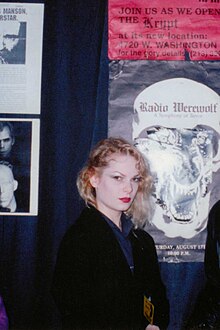Christoph D.
| Radio Werewolf | |
|---|---|

Zeena Schreck as co-director of Radio Werewolf at the Berlin Independence Days Music Festival 1989
|
|
| Background information | |
| Origin | Los Angeles, California, United States |
| Genres | Deathrock, experimental, post-industrial, neoclassical, gothic rock, dream pop, electronica, dark wave, ambient, post-punk |
| Years active | 1984-1993 |
| Past members |
Nikolas Schreck Zeena Schreck Kirby Vladimir Rosinski Christoph D. Evil Wilhelm Paul Antonelli James Collord |
Radio Werewolf were a stylistically eclectic musical collective active in Los Angeles, California and Europe from 1984 to 1993.
Radio Werewolf was founded in Los Angeles in 1984, by Nikolas Schreck (vocals), Evil Wilhelm (percussion), James "Filth" Collord (bass) and Nathan Pino (hammond organ.) When Nathan Pino was asked to leave the band, he was replaced on the keyboard (known by Radio Werewolf as the Lycanthropachord) by Paul Antonelli, formerly with the band Animotion.
Holding a series of controversial theatrical ritual events billed as Radio Werewolf Youth Rallies at such landmark Sunset Strip venues as The Whisky A Go Go, the Roxy, and Club Lingerie, as well as at pioneering Gothic underground clubs The Krypt, The Scream, and Zombie Zoo, the band attracted a cult following they came to identify as the "Radio Werewolf Youth Party." As such, Radio Werewolf claimed that their sound was part of a musical purist movement, designed to evoke feelings of power and harmony through the use of the "dominant frequency" which lead vocalist Nikolas Schreck described in the liner notes of the 1989 Radio Werewolf album The Fiery Summons as sonic magic.
Although this early Radio Werewolf formation recorded many of their signature songs on a 1987 studio album which has since been widely bootlegged, the only official release of music from these sessions was Buried Alive, on the American Gothic LP compilation released by Bomp! and Gymnastic Records in 1988. The 1988 black comedy film Mortuary Academy featured Radio Werewolf as themselves performing 1960 Cadillac Hearse another song featured on their first unreleased album.
Radio Werewolf's live performances from 1984-1988 in Los Angeles sparked a heated controversy due to the nature of the song material. While Schreck and the rest of the band would later refer to their work as mainly a theatrical performance designed to emulate specific aspects of history or culture, songs like "Pogo the Clown" (about serial killer John Wayne Gacy), "The Night" (about a lovesick vampire), and "Incubus" (about a girl being visited by an Incubus), were pointed to by critics as condoning necrophilia and literal vampirism. Adding to the controversy of the band was a number of references to National Socialism. The biggest was the song "Triumph of the Will," named after a Nazi propaganda film. The song, written and sung from the point of view of an elderly former Nazi reminiscing about Nazi Germany, incorporating such lyrics as "Eva, oh Eva, come sit on my face; Berlin is burning and we are the master race," was intended as obvious black humor. The band also had a song called "Strength through Joy," named after the Nazi slogan and recreational program. Here again, the band's musical choice to use a tinny concertina and exaggerated Oom-pah rhythm makes clear the intended parody. Their cover version of the Nancy Sinatra song "These Boots Were Made for Walking" features the sound of army marching in the background, as well as Zeena singing a few lines in German. For the Maxi-singles cover, Zeena sported a similar costume as the film character Ilsa, She Wolf of the SS. Schreck explains in a 2011 interview that this track was a deliberate self-parody of their own public image at the time. Schreck stated that, "Black humor, sarcasm, and irony were always essential to the Radio Werewolf experience." Considering the L.A. Punk rock, Post-punk and Deathrock music scenes of the early 80s, from which Radio Werewolf arose, helps to place their use of Nazi imagery and themes in context with other bands of that time who also used such imagery.
...
Wikipedia
